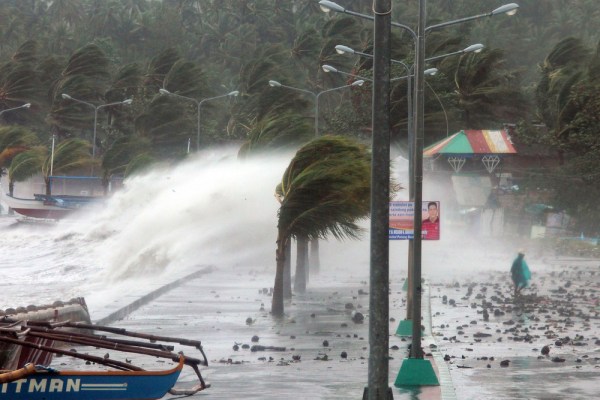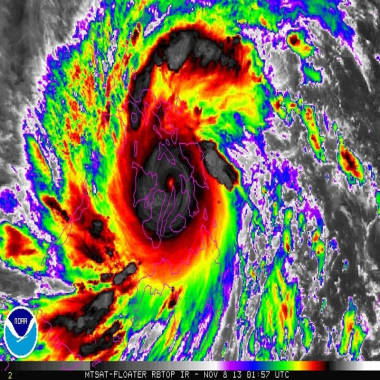'Most powerful storm ever to make landfall' batters Philippines; 3 deaths confirmed

Charism Sayat / AFP - Getty Images
The most powerful storm ever to make landfall battered the Philippines with winds approaching 200 mph early Friday.
More than one million people fled in search of safety ahead of category-five super typhoon Haiyan, which caused mudslides, flash flooding and a storm surge with waves of up to 30 feet.
At least three people were killed and seven injured, national disaster agency spokesman Rey Balido told reporters in Manila.

NOAA via Reuters
Typhoon Haiyan is pictured in this NOAA satellite handout image taken Friday.
But with the country’s lines of communication cut, officials feared the toll could rise dramatically.
“It is the most powerful storm ever to make landfall,” Weather Channel lead meteorologist Michael Palmer told NBC News. “It is as strong a typhoon as you can get, basically.”
Haiyan made landfall with winds near 195 mph. Typhoons and cyclones of that magnitude can blow apart storm-proof shelters due to the huge pressure they create, which can suck walls out and blow roofs off buildings.
Authorities in the Philippines earlier warned that 12 million people are at risk.
"The humanitarian impact of Haiyan threatens to be colossal," said Patrick Fuller, spokesman for the International Federation of Red Cross and Red Crescent Societies.
The storm pounded the islands of Leyte and Samar and the northern part of Cebu Province felt its wrath early Friday.
Some forecasters are saying Typhoon Haiyan could bring widespread devastation. NBC's Brian Williams and Miguel Almaguer report.
"Please do not underestimate this typhoon. It is very powerful. We can feel each gust," Roger Mercado, governor of Southern Leyte province, told DZBB radio. "We lost power and all roads are impassable because of fallen trees. We just have to pray."
Mercado added that more than 100 coastal homes were flattened, while landslides destroyed houses in the hills.
Palmer said gusts of 220 mph had been recorded. “That is the equivalent of EF4 tornado winds -- even EF5," he added. "You would not be able to stand up, it would knock you off your feet and blow you away. And it’s going to obliterate poorly constructed homes and outbuildings. Sturdier buildings will withstand it but with damage.”
Despite the strong winds, Palmer warned the storm surge presented the most danger. “Usually that’s what causes the most death and destruction,” he said.
Meteorologists had expected Haiyan to reduce in power as it approached the coast but it hit the Pacific islands at its peak power.
The system will now move on to Vietnam and Laos, forecasters said.
The world's strongest recorded typhoon, cyclone or hurricane to previously make landfall was Hurricane Camille in 1969, which hit Mississippi with 190 mph winds, according to Jeff Masters, a hurricane expert and director of meteorology at Weather Underground.
An average of 20 typhoons slam into the Philippines every year. In 2011, typhoon Washi killed 1,200 people, displaced 300,000 and destroyed more than 10,000 homes. Haiyan is the 24th such storm to batter the Philippines this year.
Typhoon Bopha last year flattened three coastal towns on the southern island of Mindanao, killing 1,100 people and causing damage estimated at more than $1 billion.
No comments:
Post a Comment